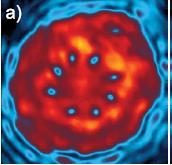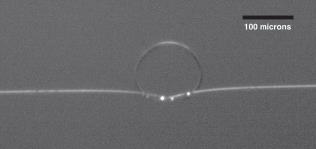Title:Quantum manipulation of polaritons and hybrid nanophotonics with nanocrystals
Speaker:Prof. Alberto Bramati
Host:Prof. E Wu
Time:10:00am, January 17, 2018
Venue:Room 385, Science Building, ECNU Zhongbei Campus
Biography:
Prof. Alberto Bramati, Full Professor at UPMC, Member of the Institut Universitaire de France.
Alberto Bramati received his PhD in physics in 1998 at the Laboratoire Kastler Brossel of the University Pierre et Marie Curie (UPMC) and Ecole Normale Supérieure, on the generation of squeezed states in semiconductor lasers. After a two-years post-doc in the group of Pr. Lugiato and Pr. Di Trapani on optical solitons and quantum imaging, in 2001 he was recruited as assistant professor at UPMC. In 2006 he was elected to the Institut Universitaire de France as junior member. Appointed full professor in 2007, he is currently carrying out his research activity at the Laboratoire Kastler Brossel. His main research topics are in the framework of Quantum Optics, Quantum Information and Nano-Photonics. In the last years he focussed on the study of polariton systems and semiconductor nanocrystals obtaining several pioneering results: among them are the first demonstration of polariton superfluidity, hydrodynamic dark solitons and polarized single photon sources. He co-authored more than 100 papers in international journals (including 1 Science, 3 Nature Phys., 2 Nature Photonics, 3 Nature Communications, 2 Scientific Reports, 16 PRL), two books chapters and gave several invited talks in international conferences and various tutorials in international schools. He supervised 12 PhD students.
Abstract of the talk:
In the first part of the talk I will describe our recent experiments on microcavity polaritons. Polaritons, the half-light-half-matter particles arising from the strong coupling between excitons and photons, behave like weakly interacting composite bosons. Due to their excitonic part they exhibit non-linear interaction while their photonic part allows creating and detecting them optically.These ingredients make polariton systems a unique platform to study quantum fluid effects in a semiconductor chip [1].
I show how the implementation of optical traps for polaritons allows for the realization of vortex-antivortex lattices in confined geometries and how the development of flexible all-optical methods to inject a controlled orbital angular momentum in such systems results in the observation of patterns of same sign vortices [2, 3]. These results open the way to the study of Abrikosov-like physics and new vortex collective phenomena in quantum fluids of light.
In the second part of the talk I will focus on our studies on core/shell colloidal semiconductor nanocrystals as very efficient room temperature single photon emitters. In particular, asymmetric core/shell nanoparticles (dots-in rods) with a spherical CdSe core surrounded by a rod-like CdS shell, are“state of the art” blinking-free sources of polarized single photons on-demand [4].
I will discuss the different strategies we are pursuing to develop hybrid photonic devices by coupling single nanocrystals with photonic structures as nanofiber-based optical resonators, deep parabolic mirrors [5], liquid crystals [6] and semiconductor nanowires [7]. The deposition of a single emitter on a nanofiber and the observation of single photon statistics through the guided mode of the fiber will be reported. Finally I will show how this hybrid system is a very promising playground for novel chiral optics experiments, including a spin-orbit coupling effect for light.

Fig.1: Chain of same sign vortices

Fig.2: Nano-Fiber based toroidal/knot resonator
[1] I. Carusotto and C. Ciuti, Quantum Fluids of Light, Rev. Mod. Phys. 85, 299(2013).
[2] T. Boulier, H. Terças, D. D. Solnyshkov, Q. Glorieux, E. Giacobino, G. Malpuech and A. Bramati, Vortex chain in a resonantly pumped polariton superfluid, Scientific Reports 5, 9230 (2015).
[3] T. Boulier, E. Cancellieri, N.D. Sangouard, Q. Glorieux, A. V. Kavokin, E. Giacobino, A. Bramati, Injection of orbital angular momentum and storage of vortices in polariton superfluids, to appear , Phys. Rev. Lett. (2016).
[4] F. Pisanello, G. Leménager, L. Martiradonna, L. Carbone, S. Vezzoli, P. Desfonds, P.D. Cozzoli, J.P. Hermier, E. Giacobino, R. Cingolani, M. DeVittorio & A. Bramati, Non-blinking single photon generation with anisotropic colloidal nanocrystals : toward Room-temperature efficient colloidal quantum sources, Advanced Materials, 25, 1974 (2013).
[5] V. Salakhutdinov, M. Sondermann, L. Carbone, E. Giacobino, A. Bramati, G. Leuchs, Optical trapping of nanoparticles by full solid-angle focusing , Optica (2016).
[6] L. Pelliser, M. Manceau, C. Lethiec, D. Coursault, S. Vezzoli, G. Leménager, L. Coolen, M. DeVittorio, F. Pisanello, L. Carbone, A. Maître, A. Bramati, E. Lacaze, Alignement of Rod-Shaped Single Photon Emitters driven by Line Defects in Liquid Crystals, Adv. Funct. Mat. 25, 1719 (2015).
[7] W. Geng, M. Manceau, N. Rahbany, V. Sallet, M. De Vittorio, L. Carbone, Q. Glorieux, A. Bramati, C. Couteau, Localised excitation of a single photon source by a nanowaveguide, Scientific Reports 6, 19721 (2016).

